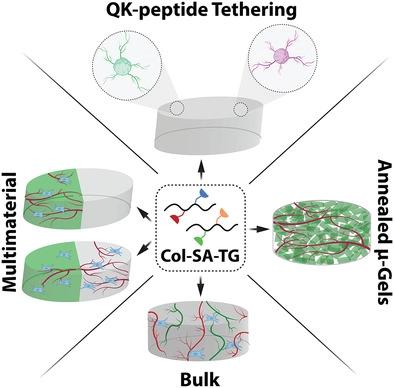当前位置:
X-MOL 学术
›
Adv. Mater.
›
论文详情
Our official English website, www.x-mol.net, welcomes your
feedback! (Note: you will need to create a separate account there.)
Enzymatically Crosslinked Collagen as a Versatile Matrix for In Vitro and In Vivo Co-Engineering of Blood and Lymphatic Vasculature
Advanced Materials ( IF 27.4 ) Pub Date : 2023-02-01 , DOI: 10.1002/adma.202209476 Dominic Rütsche 1, 2 , Monica Nanni 2, 3 , Simon Rüdisser 4 , Thomas Biedermann 2 , Marcy Zenobi-Wong 1
Advanced Materials ( IF 27.4 ) Pub Date : 2023-02-01 , DOI: 10.1002/adma.202209476 Dominic Rütsche 1, 2 , Monica Nanni 2, 3 , Simon Rüdisser 4 , Thomas Biedermann 2 , Marcy Zenobi-Wong 1
Affiliation

|
Adequate vascularization is required for the successful translation of many in vitro engineered tissues. This study presents a novel collagen derivative that harbors multiple recognition peptides for orthogonal enzymatic crosslinking based on sortase A (SrtA) and Factor XIII (FXIII). SrtA-mediated crosslinking enables the rapid co-engineering of human blood and lymphatic microcapillaries and mesoscale capillaries in bulk hydrogels. Whereas tuning of gel stiffness determines the extent of neovascularization, the relative number of blood and lymphatic capillaries recapitulates the ratio of blood and lymphatic endothelial cells originally seeded into the hydrogel. Bioengineered capillaries readily form luminal structures and exhibit typical maturation markers both in vitro and in vivo. The secondary crosslinking enzyme Factor XIII is used for in situ tethering of the VEGF mimetic QK peptide to collagen. This approach supports the formation of blood and lymphatic capillaries in the absence of exogenous VEGF. Orthogonal enzymatic crosslinking is further used to bioengineer hydrogels with spatially defined polymer compositions with pro- and anti-angiogenic properties. Finally, macroporous scaffolds based on secondary crosslinking of microgels enable vascularization independent from supporting fibroblasts. Overall, this work demonstrates for the first time the co-engineering of mature micro- and meso-sized blood and lymphatic capillaries using a highly versatile collagen derivative.
中文翻译:

酶交联胶原蛋白作为一种多功能基质,用于血液和淋巴血管系统的体外和体内协同工程
许多体外工程组织的成功翻译需要充分的血管形成。本研究提出了一种新型胶原蛋白衍生物,它含有多种识别肽,用于基于分选酶 A (SrtA) 和因子 XIII (FXIII) 的正交酶促交联。SrtA 介导的交联使人体血液和淋巴微毛细血管和中尺度毛细血管在散装水凝胶中的快速协同工程成为可能。虽然凝胶刚度的调整决定了新血管形成的程度,但血液和淋巴毛细血管的相对数量概括了最初接种到水凝胶中的血液和淋巴管内皮细胞的比例。生物工程毛细血管很容易形成管腔结构,并在体外和体内表现出典型的成熟标志物。二级交联酶 XIII 因子用于将 VEGF 模拟 QK 肽原位束缚到胶原蛋白上。这种方法支持在没有外源性 VEGF 的情况下形成血液和毛细淋巴管。正交酶促交联进一步用于生物工程水凝胶,其具有空间限定的聚合物组合物,具有促和抗血管生成特性。最后,基于微凝胶二次交联的大孔支架使血管形成独立于支持的成纤维细胞。总的来说,这项工作首次展示了使用高度通用的胶原蛋白衍生物共同设计成熟的微型和中型血液和淋巴毛细血管。这种方法支持在没有外源性 VEGF 的情况下形成血液和毛细淋巴管。正交酶促交联进一步用于生物工程水凝胶,其具有空间限定的聚合物组合物,具有促和抗血管生成特性。最后,基于微凝胶二次交联的大孔支架使血管形成独立于支持的成纤维细胞。总的来说,这项工作首次展示了使用高度通用的胶原蛋白衍生物共同设计成熟的微型和中型血液和淋巴毛细血管。这种方法支持在没有外源性 VEGF 的情况下形成血液和毛细淋巴管。正交酶促交联进一步用于生物工程水凝胶,其具有空间限定的聚合物组合物,具有促和抗血管生成特性。最后,基于微凝胶二次交联的大孔支架使血管形成独立于支持的成纤维细胞。总的来说,这项工作首次展示了使用高度通用的胶原蛋白衍生物共同设计成熟的微型和中型血液和淋巴毛细血管。基于微凝胶二次交联的大孔支架使血管形成独立于支持的成纤维细胞。总的来说,这项工作首次展示了使用高度通用的胶原蛋白衍生物共同设计成熟的微型和中型血液和淋巴毛细血管。基于微凝胶二次交联的大孔支架使血管形成独立于支持的成纤维细胞。总的来说,这项工作首次展示了使用高度通用的胶原蛋白衍生物共同设计成熟的微型和中型血液和淋巴毛细血管。
更新日期:2023-02-01
中文翻译:

酶交联胶原蛋白作为一种多功能基质,用于血液和淋巴血管系统的体外和体内协同工程
许多体外工程组织的成功翻译需要充分的血管形成。本研究提出了一种新型胶原蛋白衍生物,它含有多种识别肽,用于基于分选酶 A (SrtA) 和因子 XIII (FXIII) 的正交酶促交联。SrtA 介导的交联使人体血液和淋巴微毛细血管和中尺度毛细血管在散装水凝胶中的快速协同工程成为可能。虽然凝胶刚度的调整决定了新血管形成的程度,但血液和淋巴毛细血管的相对数量概括了最初接种到水凝胶中的血液和淋巴管内皮细胞的比例。生物工程毛细血管很容易形成管腔结构,并在体外和体内表现出典型的成熟标志物。二级交联酶 XIII 因子用于将 VEGF 模拟 QK 肽原位束缚到胶原蛋白上。这种方法支持在没有外源性 VEGF 的情况下形成血液和毛细淋巴管。正交酶促交联进一步用于生物工程水凝胶,其具有空间限定的聚合物组合物,具有促和抗血管生成特性。最后,基于微凝胶二次交联的大孔支架使血管形成独立于支持的成纤维细胞。总的来说,这项工作首次展示了使用高度通用的胶原蛋白衍生物共同设计成熟的微型和中型血液和淋巴毛细血管。这种方法支持在没有外源性 VEGF 的情况下形成血液和毛细淋巴管。正交酶促交联进一步用于生物工程水凝胶,其具有空间限定的聚合物组合物,具有促和抗血管生成特性。最后,基于微凝胶二次交联的大孔支架使血管形成独立于支持的成纤维细胞。总的来说,这项工作首次展示了使用高度通用的胶原蛋白衍生物共同设计成熟的微型和中型血液和淋巴毛细血管。这种方法支持在没有外源性 VEGF 的情况下形成血液和毛细淋巴管。正交酶促交联进一步用于生物工程水凝胶,其具有空间限定的聚合物组合物,具有促和抗血管生成特性。最后,基于微凝胶二次交联的大孔支架使血管形成独立于支持的成纤维细胞。总的来说,这项工作首次展示了使用高度通用的胶原蛋白衍生物共同设计成熟的微型和中型血液和淋巴毛细血管。基于微凝胶二次交联的大孔支架使血管形成独立于支持的成纤维细胞。总的来说,这项工作首次展示了使用高度通用的胶原蛋白衍生物共同设计成熟的微型和中型血液和淋巴毛细血管。基于微凝胶二次交联的大孔支架使血管形成独立于支持的成纤维细胞。总的来说,这项工作首次展示了使用高度通用的胶原蛋白衍生物共同设计成熟的微型和中型血液和淋巴毛细血管。











































 京公网安备 11010802027423号
京公网安备 11010802027423号